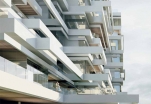10 Sustainability Advances by 10 Design

With expertise in megascale real estate development across Asia, 10 DESIGN is working with software developers to integrate innovative energy modelling techniques beyond single buildings to whole developments up to 100 hectares. This service allows our designers to define, quantify, and optimize the natural resources, energy, water, carbon, and financial benefits of relevant design strategies from the very start of design.
All of this is evaluated in real time using local currency, fuel mix, and energy costs. Unlike traditional energy modeling practices where results are delivered only at the end of design (when changes would incur significant cost), this parallel analysis process provides operational feedback throughout each stage of design. The analysis incorporates form, orientation, daylight, ventilation, facade construction, building systems, and water use, amongst others. Savings are calculated as the design progresses, ensuring operational performance is delivered in the final building.
The results immediately help developers at the masterplanning stage understand the balance between initial capital investment and long term operational costs in relation to design options. For our own design teams, this process increases understanding of the environmental impact of form, function, and articulation. Ongoing research will illustrate best practices for design, construction methodology, and operational settings tailored to each region of Asia.
1. Climate Considerations
10 Design’s staff joins us from more than 25 countries, providing expertise in every region where we work. Researching the historical conditions of a region, its climate and culture, provides opportunity to design responsively, where environment derives form. Passive design strategies may be developed through understandings of local climate: solar exposure, prevailing winds, and annual precipitation. Each project begins with research into context and climate. Schemes develop through careful coordination of dynamic forms and natural opportunities. Design, examine, and reform; performance based design.
2. Natural Systems
In the development of large scale master plans, 10 designs cities that optimize natural systems across whole developments, creating equal access to resources and improving efficiencies. Low impact development strategies including green space and storm water management create interactive public spaces that withstand the impact of extreme storm events while providing irrigation during droughts. 1.4 million sqm mixed-use residential development in Shenzhen for Top Spring international called for high density. Optimizing natural systems across the whole site created dynamic and resilient green space.
Full content of this issue you can read here
The full version of the article can be read in our printed issue, also you can subscribe to the web-version of the magazine
 Text and illustrative materials provided by 10 Design
Text and illustrative materials provided by 10 Design


